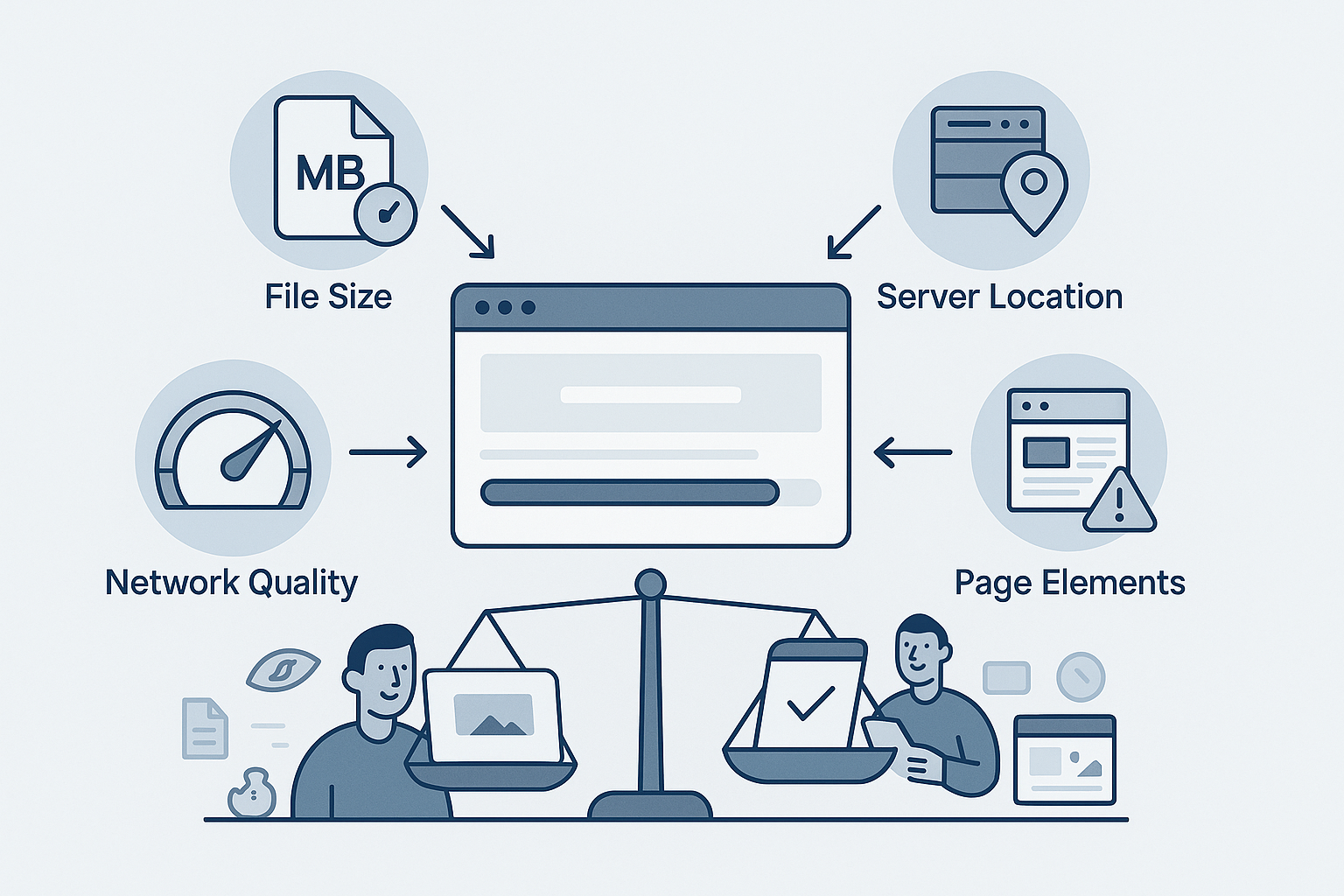
Why website speed is important?

Understanding Site Speed
Imagine visiting a restaurant where the service is sluggish—frustration mounts, and you’re less likely to return. The same applies to websites. Site speed, or how quickly a web page loads in a browser, is crucial to user satisfaction. A slow site can repel visitors, lower search rankings, and reduce overall traffic. In contrast, a fast site encourages users to stay, explore, and engage—ultimately boosting conversions.
The Significance of Site Speed
Impact on Conversion Rates
Multiple studies have shown a clear link between site speed and conversion rates—the percentage of visitors who complete a desired action (such as making a purchase or signing up for a newsletter).
- Mobify: By shaving just 100 milliseconds off their homepage load time, they saw a 1.11% increase in session-based conversions.
- AutoAnything: When this online retailer cut their page load time in half, sales increased by 12–13%.
- Walmart: Improved their conversions by 2% for every one-second increase in page speed.
These real-world examples highlight that even minor improvements in site speed can drive significant business results.
Influence on Bounce Rates
A bounce occurs when a user visits a single page and leaves without further interaction. Slow-loading websites suffer higher bounce rates because users are unwilling to wait.
- BBC found that for every extra second it took for their pages to load, they lost 10% of their users.
This shows that site speed directly impacts user retention and engagement.
Role in SEO Best Practices
Search engines like Google want to deliver the most relevant information as quickly as possible. That’s why site speed—especially on mobile devices—directly affects how websites are ranked in search results. Faster websites don’t just please users; they comply with SEO best practices, improving visibility and attracting more organic traffic.
Enhancing User Experience
Slow load times and delayed responses create a poor user experience. In today’s digital world, users expect immediate access to content. Frustrating delays can drive them away—sometimes for good.

Factors Affecting Site Speed
Page Weight
Web pages often include resources like JavaScript, videos, CSS files, and high-resolution images. The total size of these resources—also called "page weight"—directly impacts load times. As web technology advances, pages often become heavier, making optimization more challenging but even more important.
Network Conditions
Even a well-optimized website can feel slow if the user has a poor network connection. Local hardware, internet service quality, and whether a user is on a fast wired network or a slower mobile connection (such as 3G or 4G) all matter. Developers can help by:
- Minifying and compressing files
- Optimizing images
- Using a Content Delivery Network (CDN) to bring content closer to users
Hosting Location
The physical distance between a user and a website’s server impacts latency. If users are far from where a site’s data is hosted, load times increase. Hosting content on servers in multiple locations (as CDNs do) reduces this delay, making pages load faster worldwide.
Measuring Website Speed
Measuring website speed is essential to identifying and solving performance problems. Various tools—such as those from Cloudflare—analyze web pages and highlight elements that slow them down. These metrics provide actionable insights for improvement.
Key Website Performance Metrics
- Load Time: Total time for a page to fully load, including all HTTP requests and resources.
- Page Size: The combined file size of all assets a page needs. Larger sizes increase load time and use more data, which matters most for mobile users.
- Time To First Byte (TTFB): The time between the browser requesting a page and receiving the first byte of data. Faster TTFB improves user experience and SEO.
- Number of Round Trips: The number of times data must travel back and forth between browser and server. More round trips mean higher latency.
- Round Trip Time (RTT): The time it takes for a request to go to the server and back. Lower RTT means quicker responses.

Advanced Website Performance Strategies
After addressing the fundamentals of website speed, organizations and developers can implement more advanced strategies to push performance even further. These approaches can make a significant difference, especially for websites with complex architectures or high volumes of global traffic.
1. Optimize Critical Rendering Path
The Critical Rendering Path is the sequence of steps browsers take to convert HTML, CSS, and JavaScript into the pixels seen by the user. Optimizing this process can lead to noticeably faster perceived load times. Techniques include:
- Minimize render-blocking resources: Defer or asynchronously load non-essential JavaScript and CSS so they don’t delay initial rendering.
- Inline critical CSS: Embed essential CSS directly in the HTML to reduce round trips and speed up above-the-fold rendering.
- Prioritize visible content: Ensure above-the-fold content loads first for quicker visual feedback.
2. Implement Lazy Loading
Lazy loading delays the loading of non-critical resources (like images or videos below the fold) until they’re actually needed. This reduces initial page weight, speeds up first paint, and conserves bandwidth—especially important for mobile users.
3. Leverage Browser Caching
Properly configured browser caching allows returning visitors to load your website much faster. By instructing browsers to reuse previously downloaded files (such as images, CSS, and JavaScript), you reduce server load and page load time.
- Set cache-control headers to specify how long assets should be cached.
- Use versioning (cache-busting) for updated resources so users always get the latest content.
4. Use Efficient Image Formats and Optimization
Images often make up the largest portion of a page’s weight. Optimize images by:
- Serving modern formats like WebP or AVIF for better quality at smaller file sizes.
- Compressing images without sacrificing visible quality.
- Implementing responsive images (
srcsetandsizesattributes) so browsers only download images suited for the user’s device and screen size.
5. Reduce Third-Party Scripts
Each third-party script (like analytics, ads, or social widgets) can slow down your website. Audit all external scripts and only keep those that provide essential value. Where possible:
- Load scripts asynchronously or defer them.
- Use lightweight alternatives.
6. Enable HTTP/2 or HTTP/3
Modern protocols like HTTP/2 and HTTP/3 provide faster, more efficient data transfer than HTTP/1.1. They support multiplexing (sending multiple requests at once), header compression, and other enhancements. Most major browsers and CDNs support these protocols—enabling them can yield immediate speed improvements.
7. Minify and Compress Resources
- Minify JavaScript, CSS, and HTML by removing unnecessary characters and whitespace.
- Use Gzip or Brotli compression on your server to significantly reduce file sizes before they’re sent to the user.
8. Prefetch, Preload, and Preconnect
- Prefetch resources you anticipate the user will need next (like a likely-to-be-clicked link).
- Preload important resources needed immediately for rendering.
- Preconnect to required origins early, saving valuable milliseconds in establishing network connections.

Using Content Delivery Networks (CDNs) to Accelerate Your Website
A Content Delivery Network (CDN) is a powerful solution for improving website speed and reliability on a global scale. Rather than serving all website content from a single server, a CDN distributes copies of your site’s static assets (such as images, stylesheets, scripts, and videos) across a network of servers located in data centers worldwide.
Key benefits of using a CDN include:
- Reduced Latency: Content is delivered from the server geographically closest to the user, significantly lowering load times.
- Scalability: CDNs help handle traffic spikes, distribute server load, and maintain consistent performance during high demand.
- Improved Reliability: If one server is down, others can step in, reducing the risk of downtime.
- Security Enhancements: Many CDNs offer built-in protection against DDoS attacks and other security threats.
How a CDN Works:
- When a user requests a resource from your website, the CDN automatically serves it from the nearest data center.
- If the requested resource isn’t yet cached locally, the CDN retrieves it from your origin server and stores it for subsequent visitors.
- This process reduces the distance data must travel and offloads work from your main server, resulting in a faster, more resilient website.
Best Practices for CDN Implementation:
- Cache as much static content as possible—images, stylesheets, scripts, fonts, and even whole HTML pages when appropriate.
- Regularly review and fine-tune your CDN’s caching rules for optimal performance.
- Pair CDN use with other optimization techniques, such as resource minification and lazy loading, for maximum impact.
With the right blend of advanced strategies and CDN integration, you can deliver lightning-fast digital experiences—delighting users, improving SEO, and driving business results in a competitive online world.


